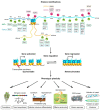Regulatory Roles of Histone Modifications in Filamentous Fungal Pathogens
- PMID: 35736048
- PMCID: PMC9224773
- DOI: 10.3390/jof8060565
Regulatory Roles of Histone Modifications in Filamentous Fungal Pathogens
Abstract
Filamentous fungal pathogens have evolved diverse strategies to infect a variety of hosts including plants and insects. The dynamic infection process requires rapid and fine-tuning regulation of fungal gene expression programs in response to the changing host environment and defenses. Therefore, transcriptional reprogramming of fungal pathogens is critical for fungal development and pathogenicity. Histone post-translational modification, one of the main mechanisms of epigenetic regulation, has been shown to play an important role in the regulation of gene expressions, and is involved in, e.g., fungal development, infection-related morphogenesis, environmental stress responses, biosynthesis of secondary metabolites, and pathogenicity. This review highlights recent findings and insights into regulatory mechanisms of histone methylation and acetylation in fungal development and pathogenicity, as well as their roles in modulating pathogenic fungi-host interactions.
Keywords: filamentous fungal pathogens; fungal pathogenicity; histone acetylation; histone methylation; pathogenic fungi–host interactions.
Conflict of interest statement
The authors declare no conflict of interest. The funders had no role in the design of the study; in the collection, analyses, or interpretation of data; in the writing of the manuscript, or in the decision to publish the results.
Figures

Similar articles
-
Epigenetic Regulation in Insect-Microbe Interactions.Annu Rev Entomol. 2025 Jan;70(1):293-311. doi: 10.1146/annurev-ento-022724-010640. Epub 2024 Dec 19. Annu Rev Entomol. 2025. PMID: 39374433 Review.
-
The Pattern and Function of DNA Methylation in Fungal Plant Pathogens.Microorganisms. 2020 Feb 8;8(2):227. doi: 10.3390/microorganisms8020227. Microorganisms. 2020. PMID: 32046339 Free PMC article. Review.
-
Research Progress on the Mechanism and Function of Histone Acetylation Regulating the Interaction between Pathogenic Fungi and Plant Hosts.J Fungi (Basel). 2024 Jul 26;10(8):522. doi: 10.3390/jof10080522. J Fungi (Basel). 2024. PMID: 39194848 Free PMC article. Review.
-
Chromatin Dynamics Contribute to the Spatiotemporal Expression Pattern of Virulence Genes in a Fungal Plant Pathogen.mBio. 2020 Oct 6;11(5):e02343-20. doi: 10.1128/mBio.02343-20. mBio. 2020. PMID: 33024042 Free PMC article.
-
Epigenomics in stress tolerance of plants under the climate change.Mol Biol Rep. 2023 Jul;50(7):6201-6216. doi: 10.1007/s11033-023-08539-6. Epub 2023 Jun 9. Mol Biol Rep. 2023. PMID: 37294468 Review.
Cited by
-
The jet-like chromatin structure defines active secondary metabolism in fungi.Nucleic Acids Res. 2024 May 22;52(9):4906-4921. doi: 10.1093/nar/gkae131. Nucleic Acids Res. 2024. PMID: 38407438 Free PMC article.
-
Systematic characterization of Ustilago maydis sirtuins shows Sir2 as a modulator of pathogenic gene expression.Front Microbiol. 2023 Apr 11;14:1157990. doi: 10.3389/fmicb.2023.1157990. eCollection 2023. Front Microbiol. 2023. PMID: 37113216 Free PMC article.
-
Exploring the female genital tract mycobiome in young South African women using metaproteomics.Microbiome. 2025 Mar 19;13(1):76. doi: 10.1186/s40168-025-02066-1. Microbiome. 2025. PMID: 40108637 Free PMC article.
-
A Genome-Wide Comparison of Rice False Smut Fungus Villosiclava virens Albino Strain LN02 Reveals the Genetic Diversity of Secondary Metabolites and the Cause of Albinism.Int J Mol Sci. 2023 Oct 15;24(20):15196. doi: 10.3390/ijms242015196. Int J Mol Sci. 2023. PMID: 37894876 Free PMC article.
-
The COMPASS Complex Regulates Fungal Development and Virulence through Histone Crosstalk in the Fungal Pathogen Cryptococcus neoformans.J Fungi (Basel). 2023 Jun 14;9(6):672. doi: 10.3390/jof9060672. J Fungi (Basel). 2023. PMID: 37367608 Free PMC article.
References
Publication types
Grants and funding
LinkOut - more resources
Full Text Sources

